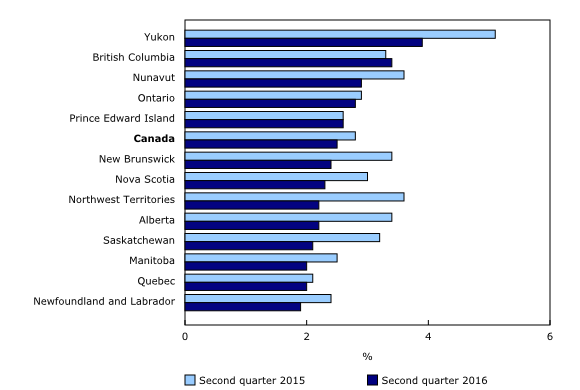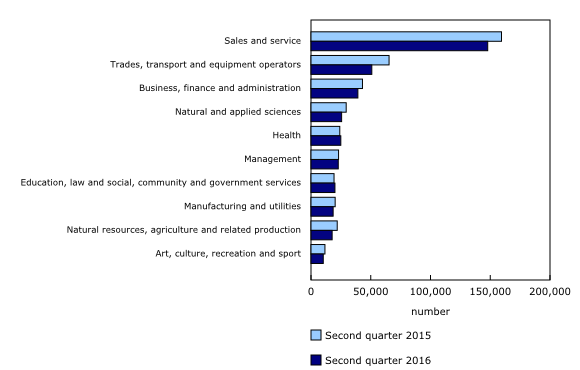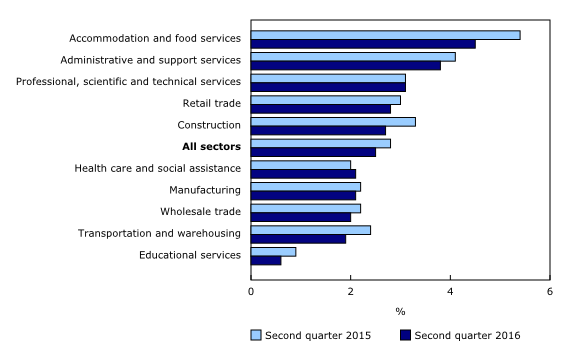Job Vacancy and Wage Survey, second quarter 2016
Archived Content
Information identified as archived is provided for reference, research or recordkeeping purposes. It is not subject to the Government of Canada Web Standards and has not been altered or updated since it was archived. Please "contact us" to request a format other than those available.
Released: 2016-10-26
Canadian employers reported 392,000 job vacancies in the second quarter, and the job vacancy rate was 2.5%.
Compared with the second quarter of 2015, the number of job vacancies declined by 45,000 (-10.3%), and the job vacancy rate decreased by 0.3 percentage points.
Job vacancy rate declines in most provinces and territories
In the second quarter, the job vacancy rate declined in seven provinces and in all of the territories compared with the same quarter a year earlier. Provincially, the largest decreases were observed in Alberta, Saskatchewan and New Brunswick. Over the same period, the job vacancy rate was little changed in Prince Edward Island, Quebec and British Columbia.
The job vacancy rate refers to the share of jobs that are unfilled out of all payroll jobs available. It represents the number of job vacancies expressed as a percentage of labour demand, that is, the sum of all occupied and vacant jobs.
In Alberta, the job vacancy rate was 2.2%, down from 3.4% in the second quarter of 2015. Over the same period, the number of job vacancies fell by 27,000 (-39.1%), the largest decline among the provinces and territories. The decrease was spread across most sectors, and was mainly for full-time positions (-25,000).
Compared with the same quarter a year earlier, the job vacancy rate in Saskatchewan declined from 3.2% to 2.1%. The number of job vacancies decreased by 5,200 (-34.4%), driven by declines in accommodation and food services (-1,400) and retail trade (-1,100).
The job vacancy rate in New Brunswick declined from 3.4% in the second quarter of 2015 to 2.4% in the second quarter of 2016, and the number of job vacancies decreased by 2,900 (-29.3%).
Over the same period, British Columbia was the only province with an increase in the number of vacancies, up 4,700 (+7.1%), driven by gains in health care and social assistance. Despite this increase, the job vacancy rate in the province was little changed.
Job vacancies by occupation
From the second quarter of 2015 to the second quarter of 2016, the number of job vacancies fell in 6 of the 10 broad occupational groups, with the largest decrease in trades, transport and equipment operators and related occupations.
Compared with the second quarter of 2015, the number of job vacancies in trades, transport and equipment operators declined by 14,000 (-22.1%). Job vacancies in this group fell by more than 50% in Nova Scotia, Saskatchewan and Alberta. Within the occupational group, motor vehicle and transit drivers recorded the largest decrease (-4,700), followed by longshore workers and material handlers (-1,500), and heavy equipment operators (-1,200).
In the second quarter, sales and service occupations had the second largest decline in the number of job vacancies, down 12,000 (-7.2%) compared with the same quarter a year earlier. In this group, occupations in food and beverage services recorded the largest decrease (-5,100), followed by retail salespersons (-4,100). At the same time, the number of job vacancies increased notably in security guards and related security service occupations (+4,200).
Provincially, the largest percentage declines for job vacancies in sales and service occupations were recorded in Alberta (-36.9%), Saskatchewan (-35.9%) and Newfoundland and Labrador (-26.6%).
In natural resources, agriculture and related production occupations, the number of vacancies decreased by 4,300 (-19.4%) from the second quarter of 2015 to the second quarter of 2016. Over this period, the number of vacancies declined the most for harvesting, landscaping and natural resources labourers (-2,300), and agriculture and horticulture workers (-1,300).
The number of job vacancies fell by 3,900 (-9.0%) in business, finance and administration occupations. The largest decreases were recorded for human resources and business service professionals (-2,800), and general office workers (-1,800). On the other hand, the number of vacancies increased by 1,500 (+29.9%) for auditors, accountants and investment professionals.
In the second quarter, the number of vacancies in natural and applied sciences decreased by 3,800 (-13.0%) compared with the same quarter a year earlier. The largest declines were in technical occupations in computer and information systems (-1,500).
In occupations in manufacturing and utilities, the number of vacancies declined by 1,700 (-8.4%), with mechanical, electrical and electronics assemblers (-900) recording the largest decrease.
Among the 500 more detailed occupation groups, food and beverage servers had the largest decline in the number of vacancies in the second quarter, down 4,300 (-30.2%) compared with the same quarter a year earlier. The decrease was evenly split between full-time and part-time positions, and the number of vacancies declined mainly in Alberta and Ontario.
The number of vacancies for retail salespersons fell by 4,100 (-16.3%) compared with the second quarter of 2015. The decline was mainly in vacancies that were for full-time positions. As a result, the proportion of full-time vacancies for retail salespersons declined from 38.3% in the second quarter of 2015 to 28.5% in the second quarter of 2016.
In the second quarter, the number of job vacancies for transport truck drivers decreased by 3,600 (-31.9%) compared with the same quarter a year earlier. Most vacancies in this group were for full-time positions (92.7%).
Job vacancy rate by sector
Compared with the second quarter of 2015, the job vacancy rate fell in 6 of the 10 largest industrial sectors in the second quarter, led by accommodation and food services, and construction. At the same time, the rate increased in health care and social assistance, while it was little changed in administrative and support services; professional, scientific and technical services; and wholesale trade.
In accommodation and food services, the job vacancy rate fell from 5.4% in the second quarter of 2015 to 4.5% in the second quarter of 2016. Over the same period, the number of job vacancies declined by 10,000 (-15.2%), driven by decreases in the food services and drinking places subsector. Despite this decline, accommodation and food services reported the highest number of vacancies in the second quarter.
Among the 10 largest industrial sectors, construction had the second largest decline in its job vacancy rate, down from 3.3% in the second quarter of 2015 to 2.7% in the second quarter of 2016. The number of job vacancies in this sector fell by 5,500 (-17.6%), with the largest decrease in construction of buildings.
Over the same period, the job vacancy rate in health care and social assistance grew from 2.0% to 2.1%, and the number of job vacancies rose by 3,400, with all of the increases in British Columbia and Ontario.
Among the smaller industrial sectors, the job vacancy rate in arts, entertainment and recreation decreased from 5.6% in the second quarter of 2015 to 3.7% in the second quarter of 2016, the largest decline of all sectors. Over the same period, the number of job vacancies fell by 4,500 (-29.9%), with the majority of the decrease in amusement, gambling and recreation industries.
Compared with the second quarter of 2015, the job vacancy rate in agriculture, forestry, fishing and hunting declined by 1.6 percentage points to 5.4%. At the same time, the number of job vacancies in this sector decreased by 3,200 (-22.5%). The decline in the number of vacancies was observed mainly in crop production.
Job vacancy rates in the economic regions
Among the 76 economic regions in Canada, Banff–Jasper–Rocky Mountain House, Alberta, recorded the highest job vacancy rate in the second quarter, at 4.5%, followed by Thompson–Okanagan, British Columbia, at 4.4%. On the other hand, the job vacancy rate in Wood Buffalo–Cold Lake, Alberta (1.3%), was among the lowest in Canada, coinciding with the wildfire evacuation in northern Alberta.
Job vacancies and offered hourly wage
The Job Vacancy and Wage Survey provides data on the average offered hourly wage for the job vacancies that businesses are trying to fill. The wage offered by an employer for a vacant position may differ from the actual wage paid once a position is filled (see the Guide to the Job Vacancy and Wage Survey for a detailed definition of average offered hourly wage).
The average offered hourly wage for all job vacancies was $19.35 in the second quarter. The highest offered wages were in Nunavut ($27.25) and the Northwest Territories ($22.20). Provincially, Ontario had the highest offered wage at $19.95, followed by Alberta ($19.75) and Newfoundland and Labrador ($19.40). Prince Edward Island had the lowest at $14.25.
Note to readers
The Job Vacancy and Wage Survey (JVWS) is a quarterly survey that provides comprehensive information on job vacancies by industrial sector, detailed occupation and skill level sought for Canada, the provinces, territories and economic regions.
JVWS data are not seasonally adjusted. Therefore, quarter-to-quarter comparisons should be interpreted with caution.
This analysis focuses on differences between estimates that are statistically significant at the 68% confidence level.
Annual wage and employment data by occupation started being collected for the wage component of the survey in 2016. The release of these data is scheduled for mid-2017.
Summary statistics related to the job vacancy time series from the Survey of Employment, Payroll and Hours are available in CANSIM.
Occupations are classified according to the National Occupational Classification (NOC) 2011. The NOC is a four-tiered hierarchical structure of occupational groups with successive levels of disaggregation. The structure is as follows: 1) 10 broad occupational categories, also referred to as one-digit NOC; 2) 40 major groups, also referred to as two-digit NOC; 3) 140 minor groups, also referred to as three-digit NOC; and 4) 500 unit groups, also referred to as four-digit NOC.
Industrial sectors are classified according to the North American Industry Classification System (NAICS) 2012. The NAICS has 20 industrial sectors at the two-digit level.
Impact of the wildfire in the Fort McMurray area on the Job Vacancy and Wage Survey collection and estimates
As a result of the wildfire in northern Alberta, which led to the evacuation of residents from the Fort McMurray area, there was no active data collection for the JVWS in the Wood Buffalo–Cold Lake economic region from May 3 to June 30, 2016. This resulted in lower response rates for the second quarter.
Using standard statistical techniques, missing data for Wood Buffalo were replaced by substituted values taken from administrative data.
Data quality of the Job Vacancy and Wage Survey
The target population of the survey includes all business locations in Canada, except those primarily involved in religious organizations and private households. While federal, provincial and territorial administrations are also currently excluded from the survey, they will be phased in at a later date.
Next release
Job vacancy data from the JVWS for the third quarter of 2016 will be released in January 2017.
Products
More information about the concepts and use of data from the Job Vacancy and Wage Survey is available online in the "Job Vacancy Component" of the Guide to the Job Vacancy and Wage Survey (75-514-G), from the Browse by key resource module of our website, under Publications.
Contact information
For more information, contact us (toll-free 1-800-263-1136; 514-283-8300; STATCAN.infostats-infostats.STATCAN@canada.ca).
To enquire about the concepts, methods or data quality of this release, contact Emmanuelle Bourbeau (613-951-3007; emmanuelle.bourbeau@canada.ca) or Myriam Hazel (613-219-4345; myriam.hazel@canada.ca), Labour Statistics Division.
- Date modified:




